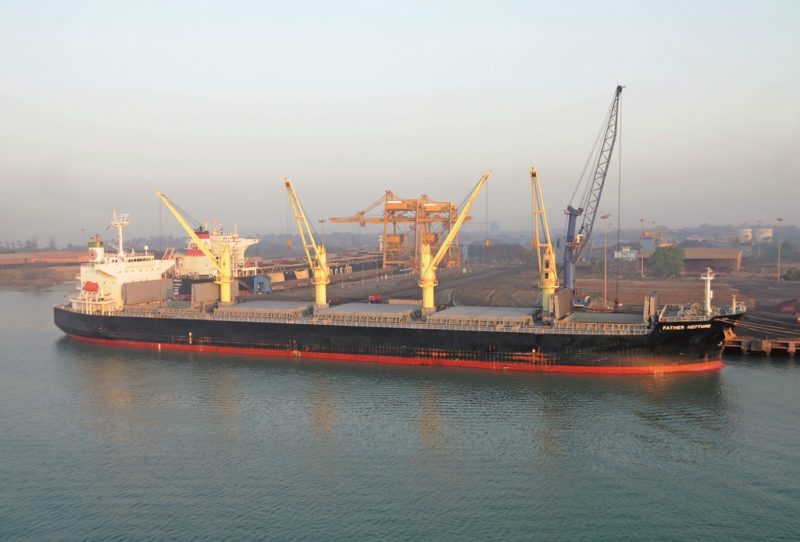
New Mangalore is an all weather port on the famous Malabar Coast at Panambur near Mangalore City in the south west coast State of Karnataka of India, with the deepest inner harbour on the south west coast of India. It is the only major port in Karnataka and the seventh largest port in India by volume of cargo handled at over 40 million tonnes per year. It is operated by New Mangalore Port Trust (NMPT) and lies roughly midway between the former Portuguese colony of Goa and the Port of Cochin near the southern tip of India. The distance between the ports of New Mangalore and Mormugao is 170 nautical miles to the north, and 191 nautical miles south to the Port of Cochin.
The New Mangalore Port Design Project was set up in 1962, with the maritime construction works started in 1968. The New Mangalore Port, the only major port of Karnataka State was completed on 4th May 1974, and was formally inaugurated by the then Prime Minister of India, Indira Gandhi, on 11th January 1975. The provisions of the Indian Major Port Trusts of 1963 were applied to New Mangalore Port Trust (NMPT) with effect from 1st April 1980. Since then, the port has been functioning as a centre of activities for importers and exporters of this region. There have been eight Chairmen of the port in the 42 years of operation from 1980, each Chairman taking the post for four or five years e.g. Capt. R. Ramkumar during 15th April 1997 to 30th April 2001. The present Chairman is Shri A. V. Ramana, who began his tenure on 11th June 2019.
Over the years, the port throughput has grown from only a few million tonnes in the early 1990s to 26.6 million tonnes in year 2003/04, 35.0 million tonnes in year 2017/18, and 40.5 million tonnes in year 2018/19 and 39.15 million tonnes in year 2019/20. Large increases in iron ore for the 3.5 million tonnes per year Kudremukh Iron Ore Co. Ltd. (KIOCL) pellet plant, coal, LPG, cement, limestone, potash, phosphates, urea, wheat and many other commodities have contributed to a huge increase in cargo throughput. Container throughput in the year 2019/20 totalled 150,000 TEU, up from 89,000 TEU in year 2016/17. The Chairman of NMPT, Shri A. V. Ramana, thanked the port managers, staff, dockers and stevedores, trades union leaders, trustees and port shipping users for their great support and co-operation, and looked forward to many more increasingly profitable years.
The major commodities exported in the port are iron ore fines, concentrates and pellets, limestone, petroleum, oil products and lubricants, granite, potash, grain, maize, pig iron and steel, rock phosphates, urea, clay, sulphur, logs, bentonite, coffee, cashew nuts, yellow peas, and container cargoes, with the major imports being coal, coke, crude oil, oil products, timber, wood pulp, liquid ammonia, phosphoric acid, fertilisers, vegetable and edible oils, liquid chemicals, and container cargoes. Coal imports in the year 2005/06 totalled 1.1 million tonnes, rising to the 2011/12 total of 4.02 million tonnes, and rising again to 6.91 million tonnes in the following year, and to 15.0 million tonnes in the year 2019/20. It is the main reason for the port’s expanding success story, with 4.0 million tonnes of coal handled by NMPT each year destined for the Udupi Power Station of 1,200 megawatt power, which was sold by Lanco Infratech to Adani Power in May 2015.

HISTORY OF MANGALORE
Mangalore has a long history dating back to the early Christian era, and is mentioned in the manuscripts of the Great Library of Alexandria in Egypt. Roman history describes Mangalore as a port on the mouth of the river Netras (Netravati), as the old port was located at the confluence of the Gurpur and Netravati rivers. Mangalore is described in Greek history as Mangala, and Ptolemy, the Greek astronomer and famous explorer of the 2nd century, makes a mention of Mangalore in his travelogue. During the time of the Vijayanagara Empire, Arab traders had established a flourishing trade in silk and spices between Mangalore and West Asia. The port is known as ‘The Gateway to Karanataka State’ with the State having a coastline of 186 miles, and also as ‘The Gateway to Kerala State’ with the State having a longer coastline of 360 miles, both lying along the line of the Western Ghats mountains that run down the spine of Western India. The Old Bundur port at the convergence of the Gurpur and Netravati rivers had many constraints in order to meet the growing sea trade of the area. The need for a new port was sorely felt and the New Mangalore Port was born.
Several great Hindu books mentioned the port, including the Ramayana and the ruler Lord Rama, and the Mahabharata and the young ruler Sahadeva, and also in the content of the Bhagavad Gila the archer Arjuna has discourse with the great god Vishna.
The port has been the centre of struggles for centuries and was ruled over by regional dynasties. Muslim merchants traded here in the 14th and 15th centuries, and the great Portuguese discoverer Vasco da Gama landed on a nearby island in 1498. The Portuguese seized the land with their colony of Goa twenty years later and held it until the late 18th century. Muslim dominance of the coastal trade had ended in 1526 when Lopo Vaz de Sampayo of Portugal defeated the Bangara king.
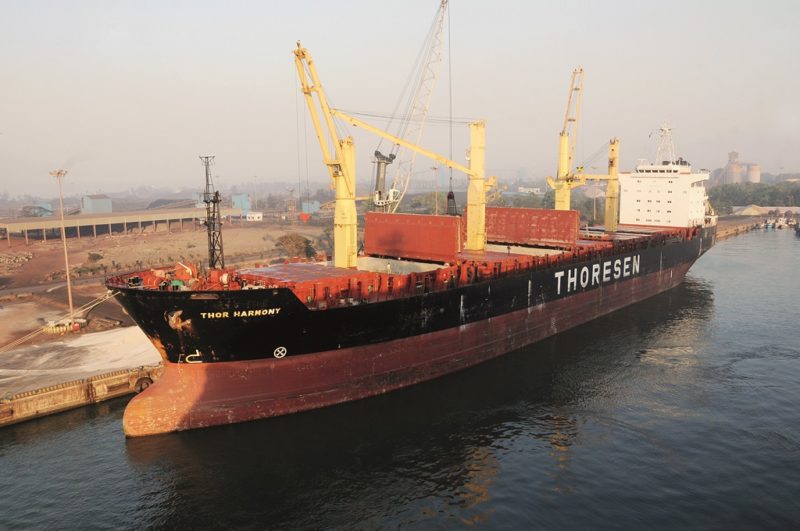
The wars between the Portuguese and the Marathas and the Goa inquisition led Brahmins and Catholics to settle further south in Mangalore, while the Portuguese restricted Arab trade to the extent that the Arabs set fire to Mangalore in 1690. The British East India Company ruled Mangalore from 1767 until 1783 when Tippu Sultan, the son of Hyder Ali, retook the city. The remains of the Tippu Sultan Fort and naval port can be found amongst the palm fringed outer areas outside the port. The Treaty of Mangalore ended the Second Anglo-Mysore War in 1784, and following two further wars, the British ruled Mangalore peaceably for a long period, building up the town of Mangalore. The town became an important British ruled trade centre, and with improvements in education, social care and health, the local municipal council was elected in 1866 with responsibility for urban planning and civic services. Manufacturing companies and cotton weavers moved into the city, and the railway arrived in 1907.
Mangalore was historically also a shipbuilding centre and a strategic port for ships sailing to the shores of Persia, Arab States, Greek and Roman cities and others. This cemented the prominence of Mangalore in many sea trades due to its presence near to the Indian Ocean, south of Cochin to major sea routes connecting the Middle East, East Africa, South Africa, and South East Asia with Europe and North and South America.
Oil was discovered off the Malabar Coast to the north of New Mangalore in 1974, and India began to hope that it might have oil in addition to coal and hydro-electric power to fuel its industrial growth. Oil output of over 12 million tonnes of refined products was soon achieved, with India self-sufficient in oil by 1986, and a major exporter of oil in large quantities today. During the decade from 1963 to 1973, output from Indian industries had increased by 150%, with exports of engineering equipment, machine tools textiles, jute, tea, railway equipment, iron and steel from Tata Iron and Steel at Jamshedpur, and transport infrastructure. India was forging ahead in engineering with over 1.6 million newly qualified engineers in 1970.
India had declared itself independent from Britain and the British Raj on 15th August 1947. The State of Mysore became the State of Karnataka in 1956, and the Port of New Mangalore opened in 1974 allowing the first ship, the 18 knot cargo-liner Satsuma Maru of 9,342 grt and 11,111 dwt of NYK and built at Nagasaki in 1956, to berth on 10th June 1974.
The Old Port of Bundur is to the south of the New Port and continued to serve the fishing trade as it had done for centuries with a big fleet of trawlers, and is still used for ferrying small parcels of cargo. The Government of India centrally administered the port until 31st March 1980, with the powers of the New Mangalore Port Trust (NMPT) taking effect on the following day. Three general cargo berths had been inaugurated on 11th January 1975, with the Oil Jetty Berth 9 commissioned four months later.
The Berth 8 iron ore Kudremukh Iron Ore Co. Ltd. (KIOCL) jetty opened on 15th August 1980, and an additional general cargo berth 5 opened on 1st February 1984 followed by Berths 6 and 7 on 7th November 1989. The deep draft container and multi-purpose general cargo Berth 14 for ships up to 90,000 dwt opened on 14th February 2006. An automated attendance system for dock workers began in use in December 2006, with a Cruise Ship Lounge operating from April 2008.
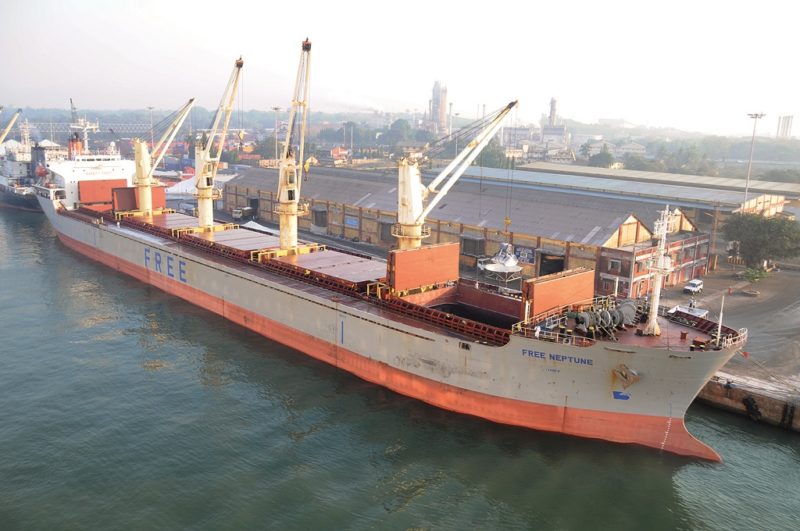
The new Coal Berth 15 opened in December 2011, with a sister Berth 16 opened on 24th May 2019 by Government Shipping Minister Gopal Krishna in the presence of NMPT Chairperson M. Beena. These two berths are 350 metres in length with a width of 25 metres and can handle coal bulkers up to 100,000 dwt. Chettinad Mangalore Coal Terminal (Pvt) Ltd. are the operators of both berths as common user coal terminals, both importing ten million tonnes of coal per year.
The new coal terminals each have two ship unloaders with a designed discharge rate of 4,000 tonnes per hour, the same rate as two nearby stackers and reclaimers of coal. After coal discharge is completed, the coal is transported from the storage yard to the rail wagon yard on a fully enclosed conveyor belt system. A rail wagon can be loaded in less than a minute, with 420 rail wagons loaded in a working day. There are at present 17 berths in operation in the port, and Berth 18 is under construction.
The port anchorage is anywhere north of the Fairway Buoy and well clear of the Approach Channel. Anchoring to the south of the Approach Channel is not advised due to the presence of shoals, mudbanks and shipwrecks. The port stevedores work on a three shift eight hour rotation, and the only time work is stopped is during the exceptional heavy monsoon periods of continuous rain. Cargo operations stop on four national holidays of Republic Day on 26th January, Labour Day on 1st May, Independence Day on 15th August, and National Father Day on 2nd October each year.

PORT OPERATIONAL BERTHS
Berth Length (m) Depth (m)
1 125.0 7.0
General cargo ships up to 4,000dwt
2 198.0 10.5
General cargo ships up to 30,000dwt
3 198.0 10.3
General cargo ships up to 30,000dwt
4 198.0 9.5
General, liquid ammonia up to 30,000dwt
5 198.0 9.5
General cargo, bulk cement up to 30,000dwt
6 198.0 9.5
General cargo ships up to 30,000 dwt
7 198.0 9.5
General cargo ships up to 30,000dwt
8 300.0 12.5
Iron ore cargoes up to 60,000dwt
9 330.0 12.5
LPG & Oil Product tankers up to 45,000dwt
Berth Length (m) Depth (m)
10 320.0 14.0
Crude Oil Jetty, tankers up to 85,000dwt
11 320.0 14.0
Crude Oil Jetty, tankers up to 85,000dwt
12 320.0 10.5
Crude & Oil Product tankers up to 50,000dwt
13 350.0 14.0
Bulk Liquids Jetty, tankers up to 85,000dwt
14 350.0 14.0
Container and mult-purpose up to 90,000dwt
15 350.0 14.0
Coal Berth, bulkers up to 90,000dwt
16 350.0 14.0
Coal Berth, bulkers up to 90,000dwt
17 350.0 14.0
Coal Berth, bulkers up to 90,000dwt
18 350.0 14.0

Under construction, bulk cargoes and containers
The present total capacity of all of the above berths is 77.9 million tonnes of cargo per annum. The commercial advantages of using the Port of New Mangalore are as follows:-
- Congestion free port
- Simplified vessel entry documentary system
- Plenty of transit sheds, warehouses and open yards for cargo stacking
- Direct delivery from harbour and mobile cranes for bulk cargoes
- Unique system of delivery of imported cargo by trucks
- Container Freight Station in close proximity to the port
- Special facilities to handle hazardous cargoes
- Large quantity open yards for coal, granite, logs, coal, wheat etc
- Alongside draft of up to 14.0 metres for liquid bulk cargoes
- Container yards secured by barbed wire fencing and high mast lighting
- Adequate number of shore docker gangs Concessional ship charges for project cargo
- Pilotage, tug and marine security services round the clock
- Deepest Inner Harbour on the West Coast Ability to handle a vast range of dry and liquid cargoes
- Port infrastructure and rail sidings continually tidy and clean
DESCRIPTION of the PORT and PORT CHARGES
The Approach Channel is of length two miles and in a due East direction to an entrance some 1,365 metres wide protected by the Northern and Southern breakwaters to the two long dock arms on the northern side of the port with berths 1 to 7, and the iron ore berths, coal berths and five oil berths on the southern side of the port.
The Sea Wall with rubble mounds at both sides of the port entrance are strong enough to protect the port from monsoon winds and storms. The Coast Guard Station and Port Signal Station are located on the Sea Wall. The port is bounded on its landward side by the Gurpur River, with the Port Office Headquarters, Customs Staff Office, Hospital, Auditorium and religious temples for regular daily worship of all staff on the landward side.
The port has huge Marshalling Yards, Coal and Grain Stacking Yards, overflow yards for immediate use, the Kudremukh Iron Ore Co. Ltd. (KIOCL) pellet plant, and the Coal Handling Yards. Liquid oil slop reception tanks are close by the tanker berths. The Turning Circle of the port in the middle of the port has a radius of 570 metres with a depth of 15.5 metres.
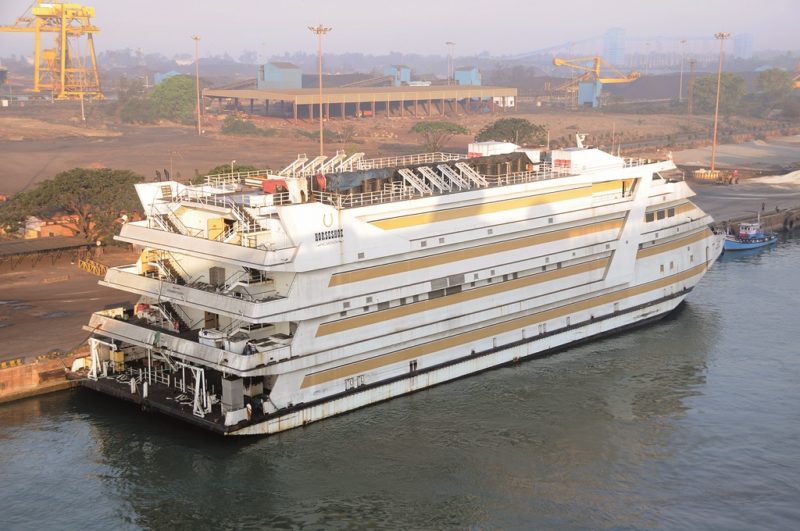
The Port Oil Spill Contingency and Waste Management Contingency Plans are in constant state of readiness for use. The storage capacities of the Transit Sheds, Covered Warehouses, and Open Stackyards, as well as Port Charges for Pilotage, Towage, Vessel Entry and Cargo Handling for a range of thirty commodities are now given in full:-
TRANSIT SHED CAPACITIES
Location Area (m2) Capacity (tonnes)
Berth 4 5,574 10,000
Berth 2 2,380 4,000
Berth 6 4,920 8,000
Other Berths 16,000 16,000
OPEN STACKYARD AREAS
Type No. Area (m2)
Bitumen covered 2 18,164
Bitumen covered 1 11,534
Non bitumen covered 1 19,693
Container Yard 1 40,000
Semi Paved Yards 1 10,000
COVERED WAREHOUSE AREAS and CAPACITIES
Owner No. Area (m2) Capacity (tonnes)
NMPT Port Trust 5 13,980 7,000
Container Station 1 2,290 4,000
CWC 3 6,870 4,000
Cons. Coffee 1 2,290 4,000
Coffee Board 1 2,290 4,000
Aspinwal & Co. 1 2,290 4,000
LIQUID STORAGE FACILITIES
Owner Tank Numbers Capacity
IOC 25 1.13 million kl of petrol products
IMC 19 52,000kl of petrol & chemicals
IPWC 8 52,846kl of molasses, edible & veg. oils
Universal Agro 3 12.800kl of edible & vegetable oils

MCF 1 10,000t of liquid ammonia
MCF 2 16,000t of phosphoric acid
Liquid Impex 2 7,500t of vegetable & edible oils
Ultra Cement 3 15,000t of bulk cement
VESSEL ENTRY CHARGES (per gt)
Vessels Foreign (US $) Coastal (R)
Over 200grt 0.332 5.38
Tugs, barges etc 0.053 2.48
Crude Oil Tankers 0.332 5.38
Crude Oil Tanker at SPM 0.332 5.38
Ro-Ro 0.332 1.79
PILOTAGE & TOWAGE CHARGES ($)
Size Charge
Small craft up to 200gt 71.34 Fixed charge
Small craft above 200gt 107.00 Fixed charge
Ships up to 30,000gt 0.320 Minimum of 960
30,000-60,000gt 0.526 + charge of 9,600
60,000gt and above 0.224 + charge of 17,280
Vessel Shifting Charges Free if at Port Convenience
Vessel Shifting Charges Per Size if at Owners Requests
Towage Services Per Job On request
The port has a modern suction dredger named Mangalore of 768 grt, and six modern similar tugs of up to 50 tonnes bollard pull and 375 grt, named Hemavathi built in 1988, Iswari, Kabini and Swarna and all built in 2009, and Varahi and Shambhavi both built in 1996.
The Benchmark Productivity of port cargoes is measured in tonnes per gang per shift as in the following table. If the cargo productivity is higher than the Benchmark Productivity, then a rebate is given of 10% for up to 10% above benchmark, 20% if up to 20% above benchmark, and 30% if up to 30% above benchmark. If, on the other hand, cargo productivity is lower than the benchmark then a penalty is charged of 10% for up to 10% below benchmark, 20% if up to 20% below benchmark, and 30% if up to 30% below benchmark.
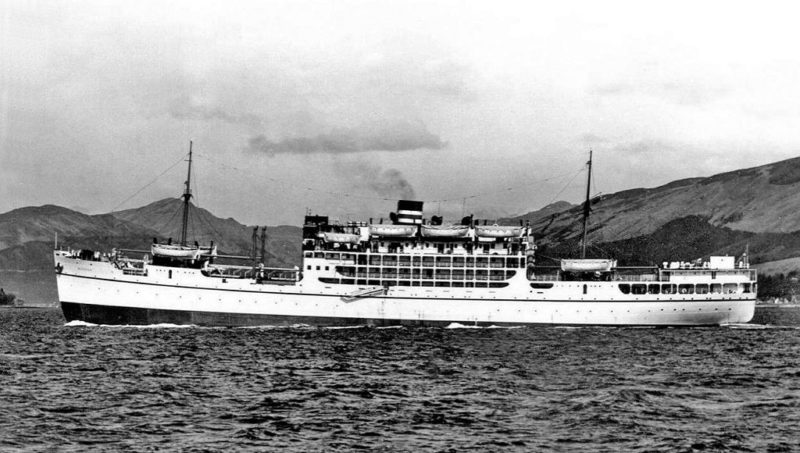
CARGO HANDLING CHARGES
Type Foreign Coastal Benchmark Productivity
(US$/t) (Rupees) (Tonnes)
Iron Ore 25 25 1,644
Coal 25 15 1,352
Limestone 25 15 1,268
Coke 35 21 792
Granite 35 21 794
Potash (MOP) 40 24 972
Maize 45 27 637
Pig Iron 45 27 440
Phosphates (DAP) 50 30 958
Rock Phosphate 50 30 944
Urea 50 30 733
Clay 30 18 220
Machinery 100 60 316
Timber 100 60 193
Wood Pulp 50 30 99
Wheat 35 21 814
Sulphur 40 24 594
Logs 100 60 94
Bentonite 45 27 840
Yellow Peas 25 15 1,034
Container per TEU 450 270 82 TEU
Other Grains 35 21 814
Other Bulks 45 45 275
Iron ore (mobile crane) 4.83 4.83 4,993
Coal (mobile crane) 4.75 2.85 4,028
Coke (mobile crane) 6.93 4.16 2,787
Stone (mobile crane) 5.38 3.23 3,772
Urea (mobile crane) 12.48 7.49 1,163
MOP (mobile crane) 4.85 2.91 5,422
DAP (mobile crane) 4.85 2.91 5,422
The Port of New Mangalore (NMPT) has a large number of small capacity harbour cranes, as well as five massive HMC Mobile Cranes of 64, 75, and 105 tonnes capacity. The benchmark capacity of Mobile Crane productivity is many times higher than that of the smaller harbour cranes, which is why important commodities are mentioned in the above table twice. The port owns three pilot launches, a mooring launch, an oil skimming craft, a buoy layer, and other harbour ancillary craft. Mallya of 337 grt is the port oil pollution recovery craft and was built in 2001 at Goa by Anderson Marine (Pvt) Ltd. as a twin screw motor vessel.

The Marine Department of the port has been updated during the last five years, as well as land developments such as the Business Development Park for new cargoes, a Testing Centre, a new Fire Fighting Facility, as well as a Pump House at Berth 13. Demurrage charges are levied on all import and export cargoes left behind in transit sheds, warehouses or open yards. The charges begin from the expiry date of free days until delivery of cargo is finally made to ship or to road and rail out of the port.
The Port of New Mangalore (NMPT) is located at position 12°57′ North, 74°48′ East and is owned by the Government of India, Ministry of Ports, Shipping and Waterways. There is a very important rail network to serve the port, with a double rail track and siding connecting the port to the nearest station at Thokur Rail Station, but passengers have to alight at Surathkal Railway Station, which is on the Konkan Railway around four miles from the port for onward rail connections. The rail links spread into the neighbouring States of Kerala, Maharashtra, and Tamilnadu besides the immediate hinterland behind the port. The rail network also extends to the cities of Chennai, Bangalore, Coimbatore, Mumbai, Kalkotta and New Delhi in addition to numerous smaller but commercially important cities. The Mangalore to Hassan rail line has been converted into a broad gauge line capable of carrying more cargo by rail, and moves improving volumes of cargo to the immediate hinterland. The broad gauge line made to connect Mangalore with Bangalore and Chennai has been modernised. The Konkan Railway has given a great boost to the port and its rail interface to the adjoining regions, as well as north to Goa, Mormugao and Mumbai.
The Port of New Mangalore (NMPT) is well connected to three highways, with the National Highway NH 66 (earlier named NH 17) passing near to the port. This highway stretches all of the way from Cochin to Mumbai via New Mangalore. The NH 48 Highway directly connects Mangalore with Bangalore, and the NH 13 Highway directly connects Mangalore with Sholapur. A new four lane Highway has recently been completed between Mangalore and Bantwal and on to Surathkal.
Major Indian and International Companies are located near to New Mangalore Port, including Mangalore Chemicals and Fertilisers (MCF), IOC (Indian Oil Company) with petroleum products, IMC Petroleum and Chemical Products, Universal Agro Exports, Mangalore Liquid Impex, IPWC Molasses and Oils, KIOCL (Kudremukh Iron & Steel Co. Ltd.), Total Gaz LPG, Ultra Tech Cement, Hindustan Petroleum Co. Ltd. (HPCL), Uttrakhand Power Corporation Ltd. (UPCL), Mangalore Refinery & Petrochemicals Ltd. (MRPL) and other oils and acids companies. Tourism is very important to the area, with cruise ships calling at the port for the coastal Karavali region of Karnataka State, and the waterways of Kerala State, with a helicopter facility to both areas of outstanding natural beauty. The New Mangalore Port Trust (NMPT) has won several green awards including the Greentech Environment Award.
The City of Mangalore lies in some of the most lush and green country in the whole of India. The many winding rivers fall from the high Western Ghats mountains to the sea, and the winding, narrow streets of the city are lined with coconut trees, beautiful flowers and plants, red tiled gabled roofs, temples and churches, and long beautiful beaches to the north and south of the port.
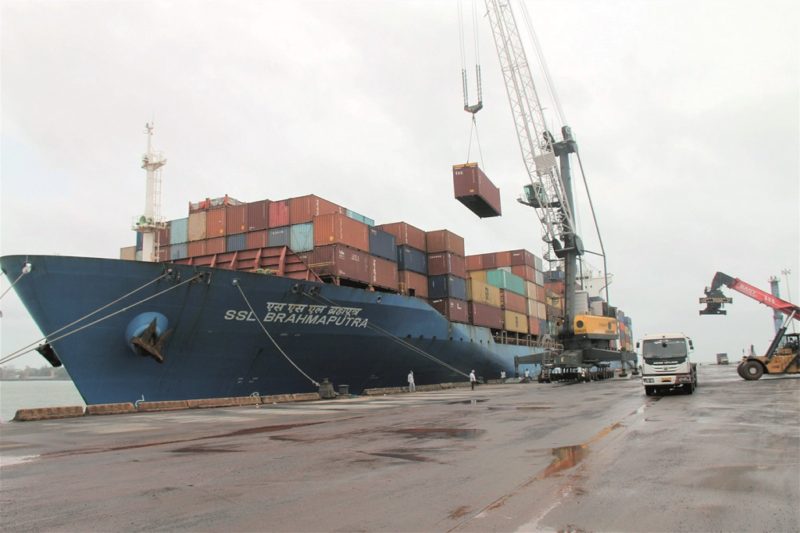
REGULAR SHIPPING COMPANIES USING NMPT SHIPPING CORPORATION OF INDIA (SCI)
SCI was founded on 2nd October 1961 and recently celebrated their Diamond Anniversary of 60 years in shipping. The Eastern Shipping Corporation and the Western Shipping Corporation amalgamated to form the first public sector shipping company in India. Crude oil shipping began in 1964, and the Jayanti Shipping Company was taken over in 1973. Passenger and cargo operations ran to East Africa, Mauritius, Malaysia, Singapore and the Indian islands of the Andamans and Nicobars in the Bay of Bengal and the Maldives and Laccadives in the Indian Ocean. Cargo only operations ran to Japan, South East Asia, Australia, the Mediterranean and Black Seas, Northern Europe, and the U.S.A. and Canada.
The passenger ships had names starting with ‘State’ e.g. State of Bombay, State of Madras, State of Haryana, State of Assam, State of Bihar, State of Gujarat, State of Kerala, State of Kutch, State of Madhya Pradesh, State of Maharashtra, State of Meghalaya, State of Mysore, State of Orissa, State of Punjab, State of Rajasthan, State of Tamilnadu, State of Travancore, State of Uttar Pradesh and State of West Bengal. The coastal passenger services from Calcutta and Madras to the Andaman and Nicobar Islands in the Gulf of Bengal were maintained by Andamans, Nicobar and Cholunga for the Indian Ministry of Home Affairs.
The Irano Hind Shipping Company was founded in 1975, a joint venture with the Islamic Republic of Iran. Mogul Line of India was taken over in 1986, chemical tankers and cryogenic operations began in 1991, container shipping began in 1993, and LNG transportation began in 2002.
A large fleet of seventy deep sea ships including a VLCC tanker of 316,000 dwt, the largest on the Indian register, was owned in 2005, with four Aframax crude oil tankers and two LR size product tankers on order. The multi purpose vessel SCI Sabarmati began trials of the first Indian deep submergence rescue vehicle in the waters off India in 2018.
SCI sailings from Iran to New Mangalore Port were halted in 2012 for four years when sanctions targeting the nuclear programme of Iran prevented the company from obtaining insurance cover for oil and other shipments. SCI had contracts with the Hindustan Petroleum Co. Ltd. (HPCL), Bharat Petroleum Corporation (BPCL), and the Mangalore Refinery & Petrochemicals Ltd. (MRPL) to ship large quantities of crude oil from Iran. The Port of New Mangalore began a trial SCI service to Male in the Seychelles in September 2021.
MOGUL LINE
Mogul Line had been established in 1877 in the Muslim pilgrim trade from India to Jeddah, and was known as the Bombay and Persia Steam Navigation Co. Ltd. and managed by Turner Morrison & Co. Ltd. of Bombay until December 1938, when it was renamed as Mogul Line. Steamers were first owned in 1880, with many cargo ships owned as well as five Muslim pilgrim ships in Islami of 5,900 grt built in 1933 by Lithgows at Port Glasgow with accommodation for 98 First Class and 1,321 deck passengers, the sisters Mohammedi and Mozaffari of 7,024 grt built by Lithgows in 1947 with accommodation for 62 First Class and 1,390 deck passengers, Saudi of 5,973 grt built in 1956 by Lithgows with accommodation for 85 First Class and 990 deck passengers, and the smaller Yerewa of 1,552 grt built by the Mazagon Dock Co. Ltd. in 1965 carrying 200 deck passengers. Mogul Line became 100% wholly owned in India in 1960, and was taken over by SCI in 1963.
GREAT EASTERN SHIPPING
Great Eastern Shipping owes its success to the foresight of two Indian families, the Sheths and the Bhiwandiwallas, who started their own shipping line to help expand the reach of their trading businesses. In 1948, a ‘Liberty’ type, Fort Ellice, was purchased and under the entrepreneurial genius of Vasant J. Sheth, the company was confidently steered ahead. Oil, dry cargo and logistics support as well as tramp shipping eventually diversified into offshore oil field services, and the company continues today to blaze an independent path with new shipping ventures. There are thirteen directors on the Board operating under a Chief Executive Officer (CEO), and which are represented on four steering committees concerned with relationships with stakeholders, onshore and seagoing staff and their remuneration, social responsibility, and the annual company audit.
A fleet of 45 ships of 3.57 million tonnes capacity is operated today, comprising four Suezmax tankers, four Aframax tankers, eighteen Long Range (LR) and Medium Range (MR) product tankers, five LPG gas tankers, two Capesize bulkers, seven Kamsarmax bulkers, and five Supramax bulkers, with all ships having the prefix ‘Jag’ to their Indian names. The five LPG tankers and most of the Kamsarmax bulkers of 82,000 dwt and the Supramax bulkers of 63,000 dwt call regularly at the New Mangalore Port Trust.
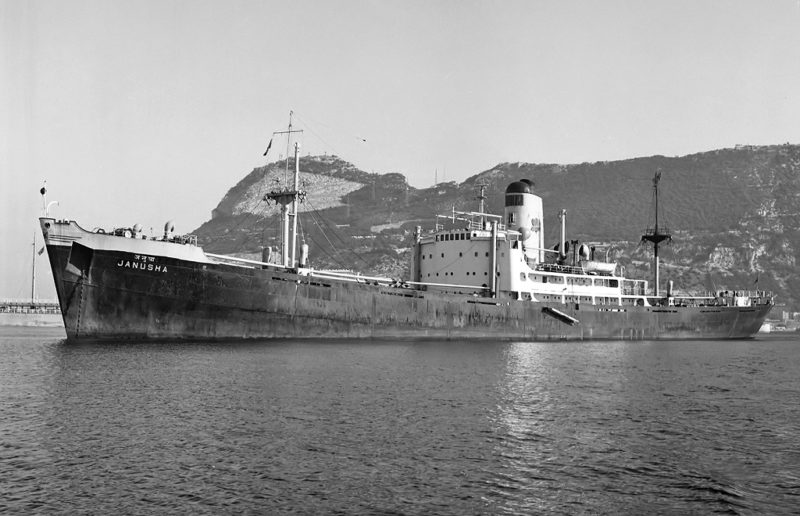
SHREYAS SHIPPING & LOGISTICS LTD. (SSL)
On 17th June 2021, the flagship container ship SSL Brahmaputra of 50,900 dwt on dimensions of overall length 260.0 metres and moulded beam of 32.35 metres became the largest container ship to dock at NMPT, and offloaded 1,142 boxes of 1,521 TEU from Mumbai. She also discharged 25,864 tonnes of raw cashew nuts, and reloaded with 300 TEU of containers at Berth 14, now the dedicated container berth instead of using several general cargo berths previously. Berth 14 is operated by Mangalore Container (Pvt) Ltd. on a public-private partnership model to handle the increased container traffic in the coming years.
SSL was established in 1988 and has a continuous shipowning history of 33 years, and is the Indian flagged subsidiary of the Transworld Group of Jebel Ali, with a fleet of eleven container ships of over 22,000 TEU. The company is listed on the Mumbai Stock Exchange and on the National Stock Exchange of India. SSL purchased a trio of ships in October 2017, including SSL Brahmaputra built in 2003 as Queens Quay for E. R. Schiffahrt of Germany, and Handysize feeder container ship SSL Ganga of 1,581 TEU capacity, and multi purpose cargo ship SSL Balaji built in 2007 and the second such ship in the fleet after SSL Sabarimalai. In addition, SSL sold the SSL Sagarmala feeder container ship for breaking up at Bangladesh for US$ 1.35 million. NMPT handled only 2,000 TEU of containers in the year 2000/01, but this had increased to 150,000 TEU in the year 2020/21, with much bigger increases expected in the coming years.
MALABAR STEAMSHIP CO. LTD.
This Malabar Coast steamship company had first been registered back in 1899 with small sailing ships and early coastal steamers plying between Bombay and Cochin. The company was dissolved in 1916, but returned to coastal sailings again in 1928 with three coasters, two of them having been converted from ‘Kil’ class coastal anti-submarine sloops built in 1918 by Smith’s Dock Co. Ltd. at South Bank on Teesside and purchased and renamed Indira and Lalita of 653 grt. A third coastal steamer was Janaki of 857 grt built in 1922 by Howaldtswerle at Kiel, with the trio managed by the Aiyer (Iyer) family of Bombay.
In post-war years, both coastal and larger ships were owned, the latter for a service to Burma from Indian ports. The directors of the company received a letter on 27th November 1947 written by two shareholders objecting to the rate of commission charged by the managers of either 10% of the profits of the company or 2.5% of the freight money received each year. At the annual General Meeting on 30th December 1947, the directors accepted that they should only be charging the lower rate of 2.5% of the freight money received.
The coastal ships owned by the company were Jagdamba of 2,470 dwt built in 1933 as Ninna at Helsingor in Denmark, the sisters Jahnavi and Janaki of 1,750 dwt built in 1958/59 at Bruges by Chantiers des Flandres, Jyoti of 2,100 dwt built in 1949 as Eika and purchased in 1954. and. The larger ships for the Burma service were the war built ‘Empire’ type Janeka built by Readhead at South Shields in 1941, and the ‘Ocean’ type Janmada built by Todd-California Yards at Richmond, California in 1942. In 1954, the former Sussex Trader of 7,490 dwt and built by Laing at Sunderland in 1947, was purchased and renamed Janani, and five years later, two more steamers were added in the former five hold North Queen of 10,765 dwt built in 1953 for Livanos of Greece by Short Brothers at Pallion in Sunderland and renamed Janusha, and the former Avondene of 8,910 dwt built in 1948 by Gray at West Hartlepool renamed Januda, the latter sailing until broken up at Bombay in 1971.
The last of these larger ships was the four hold Jayalakshmi of 3,322 grt and 5,320 dwt and built in 1960 by the Hindustan Shipyard (Pvt) Ltd. on dimensions of overall length of 385.0 feet, moulded beam of 53.0 feet and a loaded draft of 32.6 feet. She had a good service speed of 14 knots from a five cylinder M.A.N. diesel engine of 3,190 dwt, with thirteen derricks of up to 30 tonnes capacity, and carried water ballast of 842 tonnes.
The largest size ever achieved by the fleet of the Malabar Steamship Co. Ltd. was eight ships in 1960, falling to six ships in 1970, and three ships in 1978. This latter trio was the coaster Janaki built in 1958, the larger Janusha built in 1953 as North Queen, and a six hold general cargo ship named Jay Arti of 10,132 grt and 16,050 dwt. The latter ship had been built in 1959 as Belvera for Belships Ltd. owned by Christen Smith of Oslo, and was an engines aft type on dimensions of overall length 158.0 metres, moulded beam of 19.5 metres and a loaded draft of 12.6 metres. She had been sold in 1967 to Great Eastern Shipping in 1967 and renamed Jag Arti, and was purchased for the Malabar Steamship Co. Ltd. fleet in 1975.
On 5th March 1971, Janaki had sailed from Calcutta with cargo for Colombo, Cochin and Bombay and bunkered at Cochin on 21st March 1971 when a dispute arose with the Customs & Excise about whether tax duty had been paid for her bunkers loaded at Calcutta. A similar dispute also arose when Jyoti bunkered at Cochin on 19th October 1971 for her voyage to Colombo. The cases were heard by the Kerala High Court at Cochin, and the court found in favour of the steamship company, although the costs of both parties had to be paid by themselves.
In May 1979, the large steamer Janusha of 1953 arrived at Bombay for breaking up by Eastern Metal Works Ltd., and the Indian coastal service along the Malabar Coast ended in the early 1980s with the former coaster Janaki renamed as Sai Nanak, with Jay Arti the last ship in the fleet when sold in 1983. The company is still registered at Nariman Point in Mumbai as freight forwarders.
CRUISE SHIP COMPANIES
Royal Caribbean International (RCI), Celebrity Cruises, Aida Cruises, Silversea Cruises, Regent Seven Seas Cruises, Oceania Cruises and Seabourn Cruises are among the cruise lines calling at New Mangalore. During the 2016/17 cruise season, 28 cruise ships and over 30,000 cruise passengers visited the port between October 2016 and April 2017. The German cruise ship Aidabella with 1,800 passengers onboard was the last ship of this cruise season when she called on 2nd May 2017. She had also visited Mumbai, Goa and her next port of call was Cochin to the south in Kerala State. Cruise ships began to call again at New Mangalore Port Trust (NMPT) at the end of 2021, following the reopening of Indian cruise ports to international cruise lines after the relaxation of COVID-9 pandemic rules.
BULKERS AND TANKERS
The New Mangalore Port Trust (NMPT) handles mainly bulkers and tankers. The gearless bulker Emma Schulte owned by the Schulte Group of Germany arrived at the port in April 2013 loaded with a record cargo of 107,102 tonnes of South African coal, with 74,102 tonnes consigned to the Bhatia Global Steel Company, and the remaining 33,000 tonnes consigned to Minerva Steel and Power Corporation. The five massive HMC mobile cranes discharged the coal at Berth 14 in four days. Coal cargoes are usually of 60,0000 tonnes e.g. the Greek bulker Akti arrived with 57,936 tonnes of coal, the Chinese bulker Shandong Hai Da of Shandong Shipping imported 56,734 tonnes of coal, and the bulker Libertas with 47,060 tonnes of coke from China all arrived in the same month of October 2021. The logger Niamul Mowla arrived in the port on 3rd September 2012 with a record cargo of 19,673 individual logs weighing just over 23,000 tonnes loaded at Yangon (Rangoon), and which were consigned to ninety timber companies in Karnataka, Kerala and Maharashtra States. Some 296,000 tonnes of logs arrived in the port as well as timber and plywood cargoes for this Malabar Coast port of New Mangalore during 2012/13.
Tankers calling at the port in recent years have included A. K. Azad of 50,000 dwt, Phoenix Beta of 97,089 dwt, Stena Paris of 42,000 dwt, Arbor of 94,873 dwt, Abyss of 90,000 dwt, Willowy of 106,500 dwt, Jo Redwood with 20,000 tonnes of High Speed Diesel (HSD), Dawn Haridwar with 20,000 tonnes of High Speed Diesel (HSD), Sanmar Sitar of 48,700 dwt with oil products, Sampoorna Swarajya with 40,000 tonnes of High Speed Diesel (HSD), Dawn Madurai with 40,000 tonnes of SKO pumping fluid, Harsha Prem of 40,000 dwt, Ratna Puja of 91,683 dwt, United Journey of 90,000 dwt, and N. S. Spirit with 42,000 tonnes of low sulphur crude oil.
The British registered, red hulled tanker Nexus Victoria, built in Japan in 2014, arrived in October 2021 with 75,000 tonnes of crude oil. The gas tankers BW Oak, Sea Ambition (ex Bow Lima), Fuji Gas, Jag Vishnu, Jag Viraat, Mid Falcon, IGLC Dicle and Gas Husky arrived with LPG cargoes, the product tanker Magnum Fortune with 11,000 tonnes of sulphur, Atlantic Miracle with 10,000 tonnes of paraxylene chemical feedstock, Sun Iris with 5,000 tonnes of paraxylene, DSW Forward with 7,000 tonnes of palm oil, and the appropriate and well named Super Hero with 9,700 tonnes of palm oil.
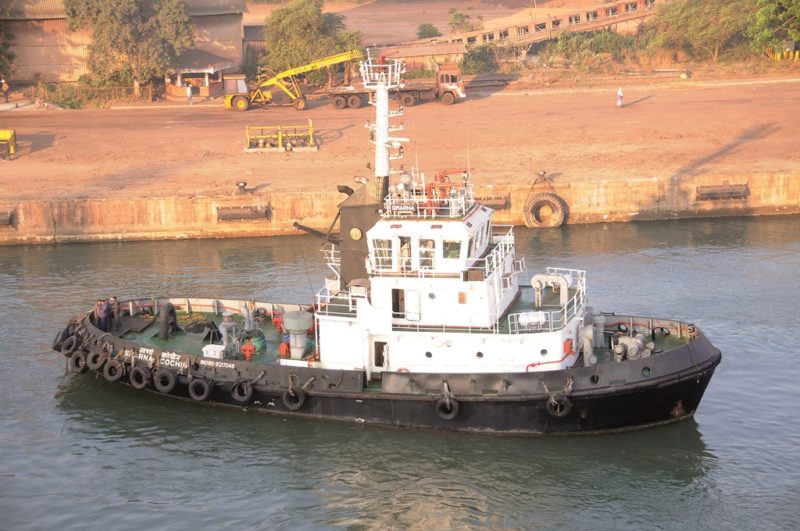
FEEDER CONTAINER SHIPS
The feeder container ships Gujurat, SSL Ganga and other SSL ships, and Tiger Goman are among many feeder container ships arriving regularly in the port. The Indian owned SSL Ganga lost a crew member overboard on 15th May 2021 shortly after sailing from New Manglore bound for Hazira in Gujurat State of India.
Three others were injured after encountering very severe weather in cyclone Tauktau. The four crew members were working on deck when a huge wave washed over them. After searching for the missing man for several hours, the ship returned to New Mangalore and the injured men were taken to hospital.
Unfortunately, a labour dispute involving truck drivers dragged on in early 2018 on indefinite strike demanding implementation of labour laws by shipping companies engaged in cargo movement at the port. The strike was in retaliation to a drastic reduction in the number of truck drivers directly employed by Port Trusts across India since the restructuring of the Indian economy since the early 1990s. The All India Port Workers Federation (AIPWF) trades union, to which all of the men belonged, is affiliated to the All India Central Council of Trades Unions (AICCTU), and had called the long strike.
The Port of New Mangalore came entirely to a halt, with only a few ship movements, as the truck drivers were employed by shipping companies, stevedoring agents, and clearing and forwarding agents, and not by the port directly. There was space for only 160 trucks on an open yard, and the Government of India then promised to build a new truck terminal of 17,000 square metres in area on a concreted yard, with driver sleeping dormitory, restaurant and gatehouse to end the strike. This new Port of New Mangalore facility will be ready for operation at the end of 2022.
POSTSCRIPT
The Port of New Mangalore is expanding very rapidly and will continue to expand from the present level of 40 million tonnes of throughput cargo plus 150,000 TEU of containers. In August 2021, the total amount of cargo shipped by the dozen ports owned by the Central Government of India rose by 11.73% to almost 60 million tonnes throughput, including at the New Mangalore Port Trust (NMPT).
Oxygen equipment was sent on 25th May 2021 by the Indian community support group in Kuwait to the Red Cross in New Mangalore to help the fight by seriously ill COVID-19 patients in the area. The Indian Government had followed the correct policy of locking down all Indian airports for over eighteen months from March 2020 until commercial flights were again allowed into the country in November 2021.





Comments
Sorry, comments are closed for this item